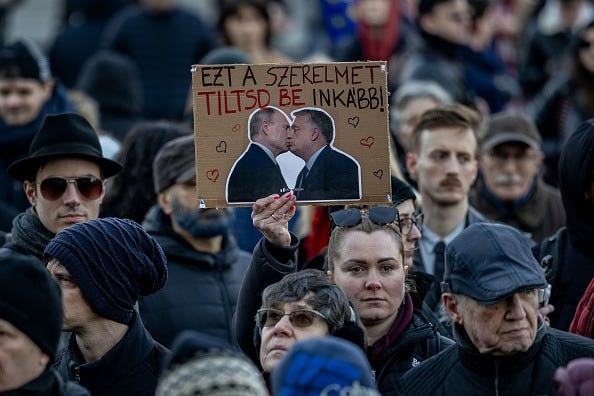How Hungary Became Putin’s EU Favorite
In 2004 Hungary joined the EU. Now, under Orbán's rule, it hosts dictators and blocks Ukraine’s accession. István, who was once in Orban’s party, watched the leader’s dramatic rightward shift.
Featured comment: The Counteroffensive was the first (and only) Substack I subscribed to. I make a point of being careful about how many subscriptions I have as they can really add up. But in an era where deep and quality journalism is increasingly seen as an anachronism of the past, outlets like the Counteroffensive are more important than ever. I just wish there was a way to magnify and amplify the incredible work you do. Keep it up!
By our subscriber Rob
Political liberalism, human rights, freedom of speech — not phrases you’d expect to hear in Viktor Orbán these days, right?
But those were the exact ideals embraced by István Hegedűs and other early members of the political party Fidesz when they initially joined with Orbán back in 1988, when it was just a youth organisation.
Orbán’s ties with Putin makes him the biggest EU antagonist of Ukraine, even with a number of other countries moving forward with Kyiv’s effort to join the European bloc. It’s this antagonism that made Hungary an ideal location of the recently-canceled Trump-Putin summit.
Hungary’s story is a warning of how easy it is to backpedal on Western liberal values. Countries that rely on Russian natural resources risk following Budapest’s example, sliding toward authoritarianism.
Hegedűs once hoped that democracy in Hungary would be reborn, but over time, he could barely recognize what was left of the party he once connected to.

The internal split within the party over shifting from a liberal-centrist vision to a right-wing one forced István to leave in 1994 and never return to parliament.
After that István had to watch from the sidelines the growing popularity of Fidesz. The country ultimately selected Orbán as prime minister, who spread nationalist narratives and made his country more illiberal and pro-Russian.

After the paywall:
Why István left the Fidesz Party;
How Orbán gradually turned into a far-right authoritarian;
Hungary as a free zone for dictators in Europe
The opposition growth in Hungary and why it’s important for Ukraine.
Keep reading with a 7-day free trial
Subscribe to The Counteroffensive with Tim Mak to keep reading this post and get 7 days of free access to the full post archives.



